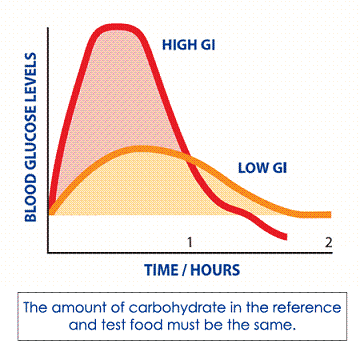Navigation:
Glycemic index
Measuring glycemic index
Carbohydrates in food
Glucose
Insulin
Factors that affect glycemic index
Glycemic load
What does glycemic load tell us
Planning a healthy meal
This is the first part of the article. For part 2 go here.
Elevated blood sugar levels can damage vital organs for the long term. When you plan your meals it may help a little if you know a thing or two about glycemic index (GI).
 Glycemic index is important when we talk about diets.
Glycemic index is important when we talk about diets.
Glycemic index of different foods
The “inventor” of GI is said to be a university professor David J. A. Jenkins who published his first article on glycemic index in 1981 in the American journal of Clinical Nutrition (The American Journal of Clinical Nutrition).
Jenkins participated in numerous clinical test about GI and is a head of the research team of nutrition experts at the Medical Faculty of the University of Toronto. He is investigating the influence of different foods and diets on diseases such as cardiovascular disease, cancer and diabetes.
GI is best determined for foods that mostly contain carbohydrates because fat and protein rich foods do not influence on the increase of blood sugar significantly.
Foods GI is classified on a scale from 0 to 100, depending on the effect on blood sugar compared to a reference food. Accordingly, the foods are defined as foods with high GI, moderate GI or lower GI.
GI foods:
Below you can find a chart of GI values.
| Glycemic INDEX | GI value |
|---|---|
| High | High 70 and more |
| Moderate | moderate from 56 to 69 |
| Low | low 55 and less |
Higher glycemic index GI means that consuming such a food will have a greater impact on your blood sugar level (blood sugar level will increase).
A food with GI of 100 is usually glucose and is considered as a reference food in GI system. Some reference laboratories as well as put food white bread, which in this case, G 100, glucose is the 140th GI.
Among the most well known institutions that are exploring GI and perform laboratory testing is the University of Sydney. An ongoing research is led by Professor Jennie Brand-Miller, PhD.
Measuring the GI
Gi is measured by laboratory testing. Testing is performed on at least ten healthy individuals who shouldn’t eat on the test day. Each of them consumes 50 grams of carbohydrates. Then, for the next two hours, the individuals give blood on a 15 minutes interval. According to the values observed graphs are formed.
Then the procedure is repeated next day. The same test is repeated – 50 grams of carbohydrates – but this time the individuals consume 50 grams of reference food – usually 50 grams of glucose.
On the basis of areas under the curves of the two graphs (a graph of a test with normal food and a graph of a test with reference food) GI is calculated for each of ten individuals. GI is then considered to be an average value of all test subjects values.
 Graph of blood glucose level values troughout the day.
Graph of blood glucose level values troughout the day.
Carbohydrates in food
Carbohydrates are divided into mono-, di- and polysaccharides. We can find carbohydrates in cereals, fruits, vegetables, legumes, and in milk and its derivatives (yogurts, ice cream). In small quantities c arbohydratesare are also present in meat (as polysaccharide glycogen). The most important task of carbohydrates is to provide carbohydrate energy.
Glucose
Different carbohydrates are transformed into glucose in different periods of time. Decomposition of polysaccharides starts in mouth, but the final decomposition happens in the intestine. Glucose passes through the intestinal wall into the bloodstream and can then be carried to the liver, muscle, brain and heart.
Older classification only distinguishes between simple carbohydrates and complex carbohydrates, depending on the number of monomer units in their molecules. In accordance with this classification it was considered that a simple carbohydrates affect blood glucose level more (levels increase) in oppose to complex carbohydrates and therefore we should enjoy especially the more complex carbohydrates and avoid more simple carbohydrates.
Later it was discovered that this rule is not always true. Both sugar and other foods can have a very different impact on the rate of increase in blood sugar.
Fruit, which contains simple sugar fructose (fruit sugar) increases the blood sugar slowly (fruits have a low GI), but on the contrary potatoes (which are rich in complex carbohydrates) has quite high GI.
Continue reading this article on page 2:
Glycemic index and glycemic load – Part 2










































[…] sugar causes quick elevation of blood sugar due to its high glycemic-index following by a fast drop of blood sugar. As a result you will feel without energy after a short […]